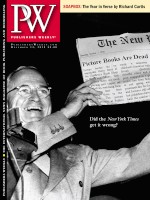In the November 8 PW, I reported from a publishing conference in Paju Book City, South Korea, and was left feeling that its unusual nature was worth further description as a possible model for other countries. The Paju Publishing Culture and Information Industrial Complex is unique. Though enjoying government support, it is a privately led venture, an entire city built for the purpose of supporting and promoting book publishing and promulgating Korean culture. Paju is guided by Hyangyak, a traditional Korean code of self-governance, with a goal to be "overflowing with dreams, courtesy, and a sense of duty."
The first phase was completed in 2007, and Paju is home to more than 200 publishers and printers, as well as literary agents, design firms, bookbinders, and distribution facilities (a cooperative owned by the publishers). Comprising more than 160 modern buildings, Paju covers more than 385 acres and includes shops, bookstores, and a "town," the latter, perhaps, the most noticeable work in progress. It's a long commute from Seoul, and that causes grumbling among some employees. Heyti Art Valley, a living/working artist colony nearby, is worthy of a day's visit itself.
An integral part of Paju is the new Asian Publication Culture and Information Center, which houses the Hotel Jijihyang, built specifically to encourage and accommodate travelers. Indeed, a visit to Paju by foreign publishers is welcomed by the Korean publishing community. Any publisher visiting Paju should contact Kwang-sung Park, who was executive chairman of Paju Book City Forum 2010 and is director of the Korean Publishers Association, and Yeon-sook Kim, director of the Paju Foundation; both are affable, knowledgeable, and charming.
Much of the credit for Paju is due to an unassuming but no less impressive man, Ki-ung Yi, chairman of Paju Book City Culture Foundation and president of Youlhwadang Publisher. A portion of the Yi family ancestral home, Sungyojang, was a model for the traditional home in Paju that serves as an entertainment space. The recently completed and very impressive Youlhwadang Library of Korean Literature and History is now home to many of the works that were collected by Yi throughout his life. He describes the publishing industry as, perhaps, not the most important industry in Korea, but certainly among the most beautiful, and one that houses the most important cultural artifacts and traditions.
More than 40 different architects from several different countries worked on the execution of Paju, headed by a committee of five architects led by Florian Beigel and Philip Christou. The original plan provided for parkland, lakes, and canals. The committee's stated goals for Paju are for it to be eco-friendly, for its design and building materials to fit into the topology of the area utilizing the Han River and nearby mountains to best effect, and to embrace the sensitivity of feng shui. Construction began in 1989 with private funds and benefited from cheap land three miles from the demilitarized zone as well as government support. It was built along the Freedom Expressway, which represents hope for a unified Korea. Six other publishers along with Ki-ung Yi of Youlhwadang Publishing met some 20 years ago at a mountain outing, and their musings led to the development of Paju. Those other publishers were Kyung-hee Kim of Jisik Sanup Publications, Eoun-ho Kim of Hangilsa Publishing, Maeng-ho Park of Minumsa Publishing, Hyung-doo Yoon of Bumwoosa, Byung-suk Chun of Moonye Publishing, and Chang-seong Heo of Pyungwa Publishing. The original seven grew to 12, then 23, and the first publishing conference was attended by more than 200.
At the most recent Paju Book City publishing forum, two high-level government officials attended and pledged their continued support of Paju as it embraces the film industry in a planned expansion of the Book City community. If the Big Six American houses ever got together at a mountain retreat to discuss something as audacious as Paju Book City, they would likely be accused of collusion.



 Volume 257
Issue 49
12/13/2010
Volume 257
Issue 49
12/13/2010





